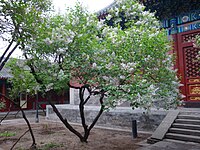Fayuan Temple
| Fayuan Temple | |
|---|---|
 The Fayuan Temple | |
| Religion | |
| Affiliation | Buddhism |
| Location | |
| Location | Beijing |
| Country | China |
| Geographic coordinates | 39°53′02″N 116°21′49″E / 39.88389°N 116.36361°E |
| Architecture | |
| Style | Chinese architecture |
| Date established | 645 |
| Completed | 1437 (reconstruction) |



The Fayuan Temple (Chinese: 法源寺; pinyin: Fǎyuán Sì), situated in the southwest quarter of central Beijing, is one of the city's oldest and most renowned Buddhist temples.
History
The Fayuan Temple, originally named the Minzhong Temple, was first built in 645 during the
Structure
It has a compact overall arrangement and buildings are arranged along the medial axis symmetrically. Main buildings there include the Gate of Temple, Heavenly King Hall, Main Hall, Hall of Great Compassion, Sutra Hall, and Bell and Drum Towers.
On both sides of the Gate of Temple stand the Bell Tower and the Drum Tower respectively. The Main Hall, which is magnificent and sacred, houses Statues of Flower Adornment School's three saints:
Taiwanese writer Li Ao, who published a novel Martyrs' Shrine: The Story of the Reform Movement of 1898 in China (another name is called "Fayuan Temple"), is about the beginning and the failure of the Hundred Days' Reform in the late Qing dynasty. He was nominated for the Nobel Prize in Literature.
References
- ^ "Fayuan Temple. Chinese Culture.org". Archived from the original on 2008-10-12. Retrieved 2009-06-11.
- ^ "Record of Restoring the Buddha Relic at Minzhong Temple". Museum of the Institute of History and Philology. Academia Sinica.
The Minzhong Temple is known today as the Fayuan Temple in Beijing. The temple was built by Emperor Li Shimin to mourn and salvage the lost souls in his failed attempt to conquer Goguryeo.
- ISBN 9781134150335. Retrieved 2 November 2016.
- ISBN 9781135935696. Retrieved 2 November 2016.
- ISBN 9781780233000. Retrieved 2 November 2016.
- ^ "China Discover Net. Beijing. Fayuan Temple". Archived from the original on 2007-05-19. Retrieved 2008-02-05.

